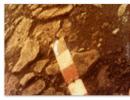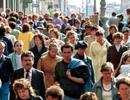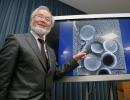What is now in the mausoleum on Red Square. Mausoleum of V. I. Lenin on Red Square. Ground modes of transport
Mausoleum V.I. Lenin- a monument-tomb located on Red Square in the city of Moscow near the Kremlin wall.
After the death of the leader of the proletariat in 1924, the workers and ordinary members of the Bolshevik Party came up with the idea not to bury Lenin's body, but to save it for future descendants. The proposal was voiced by the "all-Union headman" Mikhail Ivanovich Kalinin. Opposed, at least openly, only Leon Trotsky.
No matter what they say today, elements of Christian culture and religion were incorporated into the idea itself. In addition, the tradition of embalming their rulers takes us back to the heyday of ancient egypt, and the appearance of the structure resembles the Babylonian ziggurats (a religious building made with a ledge).
Photo 1. Mausoleum of V.I. Lenin on Red Square in the city of Moscow
Construction and history of Lenin's mausoleum
Before getting its modern look, Lenin's mausoleum was rebuilt several times. Moreover, the well-known architect Alexei Viktorovich Shchusev was the constant author or one of the participants in all construction projects.
The first wooden building next to the necropolis created on this site for the burial of prominent party figures, which had a simple cube shape with a three-stage pyramid installed on top, appeared here on the day of the funeral of Vladimir Ilyich Lenin in January 1924, and stood until the spring of the same year.
The second in time wooden Mausoleum differed from the first project only by the addition to the previous stepped volume of stands installed on both sides of the structure. The sarcophagus for the body of the leader, which stood here unchanged until the end of World War II, was designed by the architect Konstantin Stepanovich Melnikov.
In the period from 1929 to 1930, with the participation of the architect A.V. Shchusev and a group of authors completed the construction of the current Lenin Mausoleum. The project was based on the laconic forms of the previous building.

The building was made of reinforced concrete, part of the walls were raised from brick, lined with granite, as well as raspberry quartzite, marble and labradorite. A mourning hall with a sarcophagus and a vestibule designed by the architect Ignatius Nivinsky appeared in the interior.
In 1930, next to the Mausoleum, on both sides of it, guest stands were added, the project of which was developed by the architect I.A. Frenchman.
In July 1941, due to the threat of bombing and the capture of the capital, the body of the leader was evacuated to Tyumen, and returned back only by April 1945.
In the same year, the central tribune of the Lenin Mausoleum was erected and the interior interiors were decorated in a new way. The sarcophagus was also replaced, which, due to poorly designed glass slopes, gave unnecessary glare. The project was developed by architects Alexey Shchusev and Boris Yakovlev.

After the death of I.V. Stalin, his body was transferred to the mausoleum, which became known as the "Mausoleum of V.I. Lenin and I.V. Stalin." Before the 60-ton slab of labradorite monolith was found, on the pediment the names of the leaders were inscribed with paint over the painted over, embossed in granite, the inscription "Lenin". A new plate with the names "Lenin" and "Stalin" was installed in 1958 (after the removal of the body of Joseph Vissarionovich from the Mausoleum, in 1961 the old plate was returned to its place).
In 1973, the old sarcophagus was replaced with a new one - bulletproof. The project was developed by the designer N.A. Myzin and the famous sculptor Nikolai Tomsky.
Lenin in the mausoleum: video
The last reconstruction of the Lenin Mausoleum on Red Square was carried out in 2013. To strengthen the foundation, it was necessary to drill about 350 pits around the monolithic slab on which the structure stands, into which concrete was pumped under pressure. Over time, they will also dismantle the extension from the back, in which there is an elevator intended for climbing to the stands of the top leadership of the USSR during the time of L.I. Brezhnev.
It is worth noting that post No. 1, which today is on duty at the Tomb of the Unknown Soldier, was located here until October 1993.
The Lenin Mausoleum on Red Square is still a fairly visited place, where numerous tourists and admirers of the ideas of the proletarian leader come.
Lenin Mausoleum opening hours and how to get there
Working hours of the Mausoleum is only 3 hours a day, except Monday and Friday, from 10 am to 13.00. The visit is completely free and you will only need to pay for a cell in the luggage room if you leave things not allowed to be carried there.
The mausoleum is a monumental funerary structure, which included a chamber where the remains of the deceased were placed, and sometimes a memorial hall. Named after the tomb of the Carian king Mausolus in the city of Halicarnassus (now in Turkey; mid-4th century BC). This… … Encyclopedia of Newsmakers
MAUSOLEUM OF LENIN- on Red Square (see RED SQUARE). The monument tomb of V. I. Lenin (see LENIN Vladimir Ilyich) still keeps a crystal sarcophagus with an embalmed body. The first wooden version of the Mausoleum, which was a cube topped with ... ... encyclopedic Dictionary
Mausoleum of V. I. Lenin- a monument tomb near the Kremlin wall on the Red Square of Moscow, in the mourning hall of which a sarcophagus with the embalmed body of the founder of the Soviet socialist state in Russia Vladimir Ilyich Ulyanov Lenin is installed. ... ... Encyclopedia of Newsmakers
Mausoleum of Vladimir Ilyich Lenin- The Mausoleum of V. I. Lenin is a monument, a building near the Kremlin wall on the Red Square of Moscow, in the mourning hall of which a sarcophagus with the embalmed body of the founder of the Soviet socialist state in Russia Vladimir Ilyich is installed ... ... Encyclopedia of Newsmakers
Mausoleum of V. I. Lenin- Mausoleum of V. I. Lenin. Moscow Red Square. Gabronorite, granite, labradorite, labradorite, marble, porphyry. 19291930. Architect A. V. Shchusev. the mausoleum of V. I. Lenin in Moscow, a monument tomb near the Kremlin wall on Red Square, in ... ... Art Encyclopedia
Mausoleum of V. And Lenin- The Mausoleum of V. I. Lenin, a monument tomb near the Kremlin wall on Red Square in Moscow, in the mourning hall of which a sarcophagus with the embalmed body of Vladimir Ilyich Lenin is installed. During celebrations (demonstrations, rallies, military parades and … Great Soviet Encyclopedia
Mausoleum of V. I. Lenin- in Moscow, a tomb monument near the Kremlin wall on Red Square, in the mourning hall of which a sarcophagus with the body of V.I. Lenin is installed. During folk celebrations, the mausoleum serves as a government platform. January 27, 1924 architect A. ... ... Art Encyclopedia
Mausoleum- Lenin, Moscow. MAUSOLEUM (Latin mausoleum, from Greek Mausoleion), a monumental burial structure, including a chamber where the remains of the deceased were placed. It is named after the tomb of the Carian king Mausolus in Halicarnassus (mid-4th century to ... ... Illustrated Encyclopedic Dictionary
MAUSOLEUM- (lat. mausoleum). Magnificent tombstone of Mausolus, King of Caria, erected by his wife. Now it means generally a magnificent tombstone. Dictionary of foreign words included in the Russian language. Chudinov A.N., 1910. MAUSOLEUM ... Dictionary of foreign words of the Russian language
Mausoleum of Ho Chi Minh- (Vietnamese Lăng Chủ tịch Hồ Chí Minh) the tomb of the first president of the North ... Wikipedia
Books
- Mausoleum of Lenin, S. Khan-Magomedov. The book describes the history of the construction of the Mausoleum of V. I. Lenin on Red Square in Moscow, the construction and modification of which have been carried out for more than 20 years since 1924. All are considered in detail ... Buy for 1125 rubles
- Mausoleum of Lenin, Alexey Abramov. A story about the history of the creation of the Mausoleum of Vladimir Ilyich Lenin ...
Today is the 85th anniversary of the death of the first leader Soviet state, Marxist theorist, founder and leader of Bolshevism Vladimir Lenin (Ulyanov). On January 21, 1924, the leader of the Bolshevik Party and chairman of the Council of People's Commissars died, after which his body was subjected to special treatment and placed in the Mausoleum on Red Square.
Lenin's body has been in the Mausoleum for more than 80 years, and every year the idea of burying the leader of the Bolshevik Party has more and more supporters, at the same time, the proportion of those who find it difficult to express their attitude to this problem is growing significantly.
According to the deputy, there is no point in further keeping Lenin's body in the Mausoleum. "The presence of an ideological artifact in the center of the capital is an immoral act, senseless from the point of view of budget spending, harmful from an ideological point of view and cruel, both in relation to Lenin's relatives and in relation to people who do not share communist ideology," he said.
It is worth noting that back in 1924, the widow of Vladimir Ilyich, Nadezhda Krupskaya, and his brother Dmitry Ulyanov were against the idea of embalming Lenin's body. Meanwhile, Lenin's niece Olga Ulyanova is against the transfer of Lenin's body from Red Square today.
Among the supporters of the reburial of Lenin's body according to Christian traditions are the first vice-speaker of the State Duma Lyubov Sliska, the president of the Russian Cultural Foundation Nikita Mikhalkov, and the presidential envoy to the Central Federal District Georgy Poltavchenko.
Among the opponents of the idea of reburial, who take a very tough position, is the chairman of the Central Committee of the Communist Party of the Russian Federation Gennady Zyuganov, who said that "the initiative to remove Lenin's body is another manifestation of liberal fascism."
Pyramid on Red Square
On the day of Lenin's death - January 21, 1924 - the Central Committee of the party and the Council of People's Commissars began to receive telegrams and letters asking them not to bury the body of the leader of the Bolshevik Party.
A few days later - on January 27, 1924 - a mausoleum designed by Alexei Shchusev appeared near the Senate Tower of the Kremlin on Red Square. According to the architect's colleagues, Shchusev was familiar with the architecture of the Egyptian pyramids. It took him half a night to develop a project based on the principle of a three-stage pyramid, and less than three days to build.
As a result, Shchusev presented to the court of high-ranking officials a wooden building in the form of a cube with sides of three meters and two successively decreasing cubes at the top, egypt.kp.ru reports.
The Secret of Lenin's Embalming
The embalming of Lenin's remains began only two months after his death - at the end of March 1924. By this time, post-mortem changes in body tissues, especially Lenin's face and hands, had reached a critical point.
The task of "preserving Lenin's body" was undertaken by the chemist Boris Zbarsky and the Kharkov anatomist Vladimir Vorobyov. The latter, by the way, seeing the body of Lenin for the first time, wanted to abandon the most difficult task, but his colleagues convinced him to stay in the capital.
Zbarsky and Vorobyov faced a difficult task - to create their own special method for preserving the body of the leader, since freezing was not suitable for this - at that time, any accident could lead to defrosting of tissues, followed by their irreversible damage, writes Pharmaceutical Bulletin.
In addition, the ancient Egyptian development, mummification, did not fit, since this procedure not only loses 70 percent of the weight, but also distorts facial features.
Then the scientists decided to use embalming. In creating their method, they relied on the early studies of Nikolai Melnikov-Razvedenkov, who, back in 1896, proposed original way production of anatomical preparations with the preservation of their natural color by impregnating tissues with alcohol, glycerin and potassium acetate.
Scientists for four months worked tirelessly. As a result, Zabarsky and Vorobyov managed to solve a truly unique task - embalming the whole body with full preservation of volumes, shapes and the entire cellular and tissue structure.
Before the opening of the mausoleum, on July 26, Vorobyov and his team spent the night in the mourning hall. The Kharkov scientist doubted his work, and incessantly scolded Zbarsky, who had once persuaded him to decide on this risky business.
The fears of scientists turned out to be groundless - the government commission, which appeared in the Mausoleum the next day, recognized the results of the embalming as quite successful.
It is worth noting that the success of Zbarsky and Vorobyov depended on the work of another person - the architect Konstantin Stepanovich Melnikov, who created the first sarcophagus for the body of Lenin.
Melnikov's initial project was deemed technically difficult. Then the architect within a month developed eight more new options, one of which was approved. Melnikov's sarcophagus stood in the mausoleum until the end of World War II.
Evacuation of Lenin's body
The construction of the final, stone version of the Mausoleum began in 1929. In plan, it practically repeated the wooden mausoleum built according to the project of Shchusev. The monumental building was made in red and black colors from granite, porphyry and black labradorite. Above the entrance, in letters of red quartzite, there is an inscription: LENIN. Guest stands for 10,000 people were built on both sides of the building along the Kremlin wall.
For almost seventy years at the entrance to the Mausoleum there was a guard, established by order of the head of the Moscow garrison.
Lenin's body remained in the Mausoleum until July 1941. For the period of World War II, he had to be evacuated to Tyumen, and upon returning to Moscow in 1945, a new sarcophagus was built for Lenin, designed by Alexei Shchusev and sculptor Boris Yakovlev, Wikipedia writes.
"Attempts" on the Mausoleum
Back in the 1930s, there were people in society who did not accept or approve of the idea of preserving Lenin in the Mausoleum. In March 1934, Mitrofan Nikitin, a worker at one of the state farms in the Moscow region, tried to shoot at the leader's embalmed body. He was thwarted by a quick response guard. Nikitin shot himself on the spot, writes the Pacific Star newspaper.
Under Nikitin, a protest letter addressed to the party and government was found. It contained the following lines: “This spring of 1934, again, a lot of people will die because of hunger, dirt, epidemic diseases ... Do our rulers, who have settled in the Kremlin, not see that the people do not want such a life, that it is impossible to live like this anymore, not enough strength and will…”
Subsequently, the incidents at the Mausoleum were repeated. In November 1957, A. N. Romanov, a resident of Moscow with no fixed occupation, threw a bottle of ink into the Mausoleum, but the sarcophagus was not damaged. Two years later, one of the visitors threw a hammer into the sarcophagus and broke the glass, but Lenin's body was not damaged.
In July 1960, a much more serious incident occurred: a resident of the city of Frunze, K.N. Minibaev jumped onto the barrier and smashed the glass of the sarcophagus with a kick. As a result, glass fragments damaged the skin of Lenin's embalmed body. As the investigation showed, Minibaev had been nurturing the intention to destroy the sarcophagus since 1949, and he flew to Moscow in 1960 specifically for this.
Minibaev's act was the first in a chain of incidents that took place at the Mausoleum in the 1960s. A year later, L.A. Smirnova, passing by the sarcophagus, spat into the sarcophagus, and then threw a stone at the glass, breaking the sarcophagus. In April 1962, a resident of the city of Pavlovsky Posad, pensioner A. A. Lyutikov also threw a stone into the sarcophagus.
There was also a terrorist act in the Mausoleum. In September 1967, a certain Krysanov, a resident of the Lithuanian city of Kaunas, blew up a belt filled with explosives near the entrance to the Mausoleum. As a result, the terrorist and several other people died.
In the 70s, the Mausoleum was equipped the latest devices and equipment for controlling all engineering systems, strengthened the structures and replaced more than 12 thousand marble blocks, writes cominf.ru.
However, even after that, the incidents in the tomb of Lenin did not stop. In September 1973, when Lenin's sarcophagus was already covered with bulletproof glass, an improvised explosive device was detonated inside the Mausoleum by an unknown person. The offender and another married couple died.
Who watches over the remains of Lenin?
Employees of the Educational and Methodological Center for Biomedical Technologies, which is part of the All-Russian Scientific Research Institute of Medicinal and Aromatic Plants (NPO VILAR), are monitoring the maintenance of the vital appearance of Vladimir Lenin in proper condition. The center's staff is tasked with regularly examining Lenin's body.
Once every year and a half, specialists lower the remains into a bath with a special solution, using unique stereophoto installations and devices for this. According to scientists, over the past 20 years, the devices have not registered any changes.
This year, this procedure will be carried out for two months - from February 16 to April 16. All this time the Mausoleum will not work, writes Vechernyaya Moskva.
Specialists of the Mausoleum Group believe that today Lenin's body is in excellent condition thanks to the latest achievements of science, which cannot be said from the suit on the leader, which has to be changed from time to time.
The material was prepared by the online editors www.rian.ru based on information from RIA Novosti and open sources
Address: Russia, Moscow, Red Square
Start of construction: 1929
Completion of construction: 1930
Architect: A.V. Shchusev
Coordinates: 55°45"13.2"N 37°37"11.7"E
Object of cultural heritage of the Russian Federation
The place where, since 1924, the embalmed body of V.I. Lenin, has long ceased to be just a ritual tomb. It is considered a monument to the bygone socialist era and has the status of a museum. This is one of the main attractions of Red Square, which has already been visited by more than 120 million people. Many tourists, regardless of political beliefs, specially come to the center of the Russian capital to pass by the sarcophagus with the body of the communist leader.
View of the Mausoleum, Red Square, Spasskaya and Senate towers of the Kremlin
How did the idea of building a mausoleum come about?
The leader of the Soviet communists died on January 21, 1924. According to the official version, the idea to keep his body belonged to the workers and peasants, who sent many telegrams to the government. In them simple people asked not to have a conventional burial.
Lev Davidovich Trotsky opposed the preservation of the body, but he was in the Caucasus and did not have time to return to Moscow for the funeral, which was scheduled for January 27. Researchers consider the version of the "people's will" unlikely, since the idea of embalming the leader's body was not discussed in any way in the press, and none of the "numerous" letters was ever published anywhere.
According to another assumption, the idea of preserving the body appeared because not everyone who wished had time to say goodbye to the deceased. Delegations from different parts of Russia and from abroad came to the capital one after another, so Lenin's widow N.K. Krupskaya agreed to place the body in the crypt until the end of the farewell ceremony. However, she repeatedly spoke out against embalming.
Whatever the true reason, the country's leadership wanted to turn Lenin's body into a "red shrine" so that it would become an object of worship and a source of communist faith. Already two days after his death, the leaders of the state firmly decided to keep the body of Ilyich for as long as possible. Almost immediately, the famous architect Alexei Viktorovich Shchusev received an order for the design of the mausoleum. And the work of embalming the deceased was entrusted to Academicians Vladimir Petrovich Vorobyov and Boris Ilyich Zbarsky.

View of the Mausoleum from GUM
The history of the Kremlin tomb
The tomb was planned to be placed on Red Square. By that time, its section near the Kremlin wall was already a necropolis. The dead participants of the October armed uprising of 1917 lay here, and some party leaders were buried. When was walking Civil War, Red Army soldiers took an oath in front of the graves, and in peacetime, parades and demonstrations were held on the square.
The first mausoleum was built by the day of the official funeral - January 27th. There were severe frosts, so the frozen ground had to be blown up with dynamite. The building was erected in great haste, and there is evidence that the last nails were driven in just before the start of the ceremony of demolishing the body in the Funeral Hall. The tomb was never completed, and it stood half-finished until the spring of 1924.
The second mausoleum was also made on a wooden frame and sheathed in lacquered oak. It was ready by August 1924 and served for six years. And then it was replaced by a stone mausoleum, which has survived to this day.
When did the Great Patriotic War, the building of the tomb was disguised as a residential building. These precautions were necessary to preserve the monument during Nazi air raids. In the summer of 1941, when German troops advanced on all fronts, the body of the communist leader was evacuated to Tyumen. It was kept in the building of the Agricultural Academy, and in April 1945 was returned to the capital.
From 1953 to 1961, the embalmed body of Stalin lay next to the body of Lenin. And in the 1980s, behind the building of the mausoleum, an extension was made with an escalator, with the help of which the elderly leaders of the country went up to the podium.

View of the Mausoleum from Red Square
architectural features
The mausoleum fits perfectly into the architectural ensemble of Red Square and harmoniously looks against the background of the battlements of the Kremlin wall. The building has a width of 24 m and a height of 12 m. It looks like an Egyptian pyramid and is made up of five steps, built of strong and durable reinforced concrete structures and bricks. Granite, porphyry (crimson quartzite), marble and black labradorite were used in the decoration of the tomb. And above the entrance, the name of the communist leader is written in red letters.
Heavy equipment often passes through Red Square during parades. So that the architectural structure does not experience serious problems from shaking, the foundation pit, where the reinforced concrete foundation slab is located, is covered with clean sand. The last reconstruction of the building was carried out in 2013 - the builders strengthened its foundation.
For many years, Soviet leaders and leaders of the Communist Party spoke to the people from the podium of the mausoleum. However, this practice has been discontinued since 1996. Today, when Red Square is being held mass holidays, the mausoleum is protected by shields.
The Kremlin tomb is considered an integral part of the main square of the Russian capital. It is under the protection of UNESCO and is included in the World Heritage List.

Entrance to the Mausoleum
What can be seen inside
The tomb is always quiet. Visitors pass one after another along the same route and stay in the mausoleum for about a minute. There is darkness inside the building.
The funeral hall, where the sarcophagus is installed, is a square room 10 m by 10 m. It is decorated in black and red and has a stepped granite ceiling. Opposite the entrance to it there is a coat of arms of the USSR, model 1930, carved from stone. However, due to the dim lighting, it is almost impossible to see small details.
Lenin's body rests on a raised platform in a bulletproof glass sarcophagus flanked by granite railings. Such precautions were taken in 1973. Lenin is wearing a black suit, and on the left you can see the badge of a member of the Central Executive Committee of the USSR. The figure of the communist leader is specially illuminated so that those passing by can see the facial features. It contrasts sharply with the dark surroundings and therefore appears to be hologram-like.
In addition to the Funeral Hall, there is a black columbarium room in the mausoleum, in the niches of which it was planned to store the ashes of other deceased. But this room has not been used, and visitors are not allowed there.
Information for tourists
The mausoleum is open on Tuesday, Wednesday, Thursday, Saturday and Sunday from 10.00 to 13.00. During the restoration work, the schedule usually changes, but this is communicated in advance. You can get into the mausoleum for free through the checkpoint in the Nikolskaya Towerlocated from the side of the Alexander Garden. Standing in line usually takes about 30-40 minutes.

View of the Mausoleum from the Spasskaya Tower
Bulky bags, backpacks, containers with liquids and large metal objects cannot be brought into the mausoleum. If tourists have such luggage, they hand it over to a paid storage room, which is located in the Alexander Garden, near the Kutafya Tower. Everyone who wants to get into the mausoleum without fail passes through a metal detector.
Inside the tomb, you can not take photos and shoot videos. You must also hand in at the entrance. Cell phones and gadgets. If they have stayed for the duration of the visit, security officers have the right to view the latest footage, and generally ask visitors to delete these files. Near the sarcophagus, men must remove their hats.
It should be borne in mind that the entire area around the Moscow Kremlin and especially Red Square are under round-the-clock surveillance by video cameras. Tourists who come here are advised to have a passport or other identification document with them.
The first wooden version of the Mausoleum did not have a tribune. Its necessity appeared only in connection with the large influx of visitors and mourning speeches. Therefore, the following projects of the Mausoleum already provided for its presence.
Subsequently, the Mausoleum was used as a tribune, on which members of the Politburo and the Soviet government, military leaders, as well as guests of honor appeared during various kinds of celebrations on Red Square (primarily the May 1 procession and the November 7 parade, and since 1965 and the May 9 parade).
A special room was also provided, where the persons on the podium went to drink and eat. From the Mausoleum, the Minister of Defense of the USSR usually delivered a speech to the parade participants. Western "Kremlinologists" drew conclusions about the influence of certain individuals in the Politburo of the Central Committee of the CPSU and made forecasts for the future by the location of the figures on the podium of the Mausoleum during official events.
Moscow is the only city in Russia in which the reference point for road distances is not the building of the main post office of the city, but the Lenin Mausoleum. The Moscow Post Office is located a little less than two kilometers from the Mausoleum, on Myasnitskaya Street.
On March 19, 1934, Mitrofan Mikhailovich Nikitin tried to shoot at the embalmed body of the leader. He was prevented by the quickly reacting guards and visitors. Nikitin shot himself on the spot. When it was found a letter of protest content addressed to the party and governments.
On November 5, 1957, A. N. Romanov, a resident of Moscow with no fixed occupation, threw a bottle of ink into the Mausoleum. The sarcophagi with the bodies of Lenin and Stalin were not damaged.
On March 20, 1959, one of the visitors threw a hammer into the sarcophagus and broke the glass. The bodies of V. I. Lenin and I. V. Stalin were not injured.
On July 14, 1960, a resident of the city of Frunze, K. N. Minibaev, jumped onto the barrier and smashed the glass of the sarcophagus with a kick. The fragments damaged the skin of the embalmed body of V. I. Lenin. Due to restoration work, the Mausoleum was closed until August 15. During the investigation, Minibaev testified that since 1949 he had been nurturing the intention to destroy the coffin with the body of Lenin, and on July 13, 1960, he flew to Moscow specifically for this.
On September 9, 1961, L.A. Smirnova, passing by the sarcophagus, spat on it and then threw a stone wrapped in a handkerchief into the sarcophagus, accompanying her actions with curses. The glass of the sarcophagus was broken, but Lenin's body was not injured.
On April 24, 1962, pensioner A.A. Lyutikov, a resident of Pavlovsky Posad, also threw a stone into the sarcophagus. Lenin's body was not injured. Subsequently, it turned out that Lyutikov in the previous two years had written anti-Soviet letters to the central newspapers and to the embassies of Western countries.
In September 1967, a resident of Kaunas named Krysanov blew up a belt filled with explosives near the entrance to the Mausoleum. The terrorist and several other people died, the Mausoleum was not damaged.






